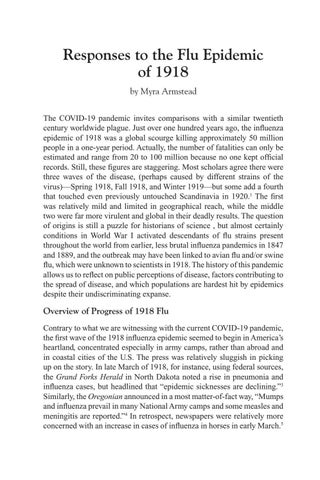Responses to the Flu Epidemic of 1918 73
Responses to the Flu Epidemic of 1918 by Myra Armstead The COVID-19 pandemic invites comparisons with a similar twentieth century worldwide plague. Just over one hundred years ago, the influenza epidemic of 1918 was a global scourge killing approximately 50 million people in a one-year period. Actually, the number of fatalities can only be estimated and range from 20 to 100 million because no one kept official records. Still, these figures are staggering. Most scholars agree there were three waves of the disease, (perhaps caused by different strains of the virus)—Spring 1918, Fall 1918, and Winter 1919—but some add a fourth that touched even previously untouched Scandinavia in 1920.1 The first was relatively mild and limited in geographical reach, while the middle two were far more virulent and global in their deadly results. The question of origins is still a puzzle for historians of science , but almost certainly conditions in World War I activated descendants of flu strains present throughout the world from earlier, less brutal influenza pandemics in 1847 and 1889, and the outbreak may have been linked to avian flu and/or swine flu, which were unknown to scientists in 1918. The history of this pandemic allows us to reflect on public perceptions of disease, factors contributing to the spread of disease, and which populations are hardest hit by epidemics despite their undiscriminating expanse.
Overview of Progress of 1918 Flu Contrary to what we are witnessing with the current COVID-19 pandemic, the first wave of the 1918 influenza epidemic seemed to begin in America’s heartland, concentrated especially in army camps, rather than abroad and in coastal cities of the U.S. The press was relatively sluggish in picking up on the story. In late March of 1918, for instance, using federal sources, the Grand Forks Herald in North Dakota noted a rise in pneumonia and influenza cases, but headlined that “epidemic sicknesses are declining.”3 Similarly, the Oregonian announced in a most matter-of-fact way, “Mumps and influenza prevail in many National Army camps and some measles and meningitis are reported.”4 In retrospect, newspapers were relatively more concerned with an increase in cases of influenza in horses in early March.5








